Scientist of the Day - Alexander Keith Johnston
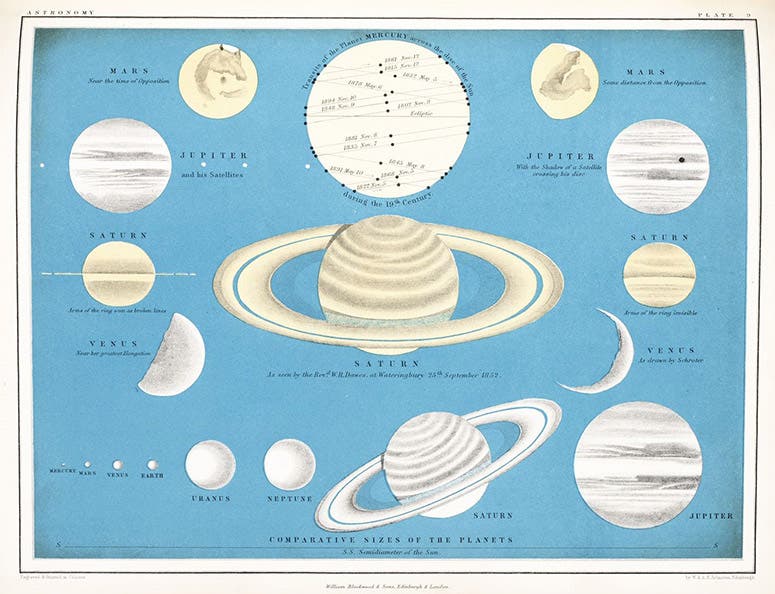
Faces of the planets of the solar system and their comparative sizes, hand-colored lithograph, Atlas of Astronomy, by Alexander Keith Johnston, plate 9, 1855 (Linda Hall Library)
Alexander Keith Johnston, a Scottish cartographer and publisher, was born Dec. 28, 1804. Johnston was the first to introduce into England the thematic atlas, which provides maps of, in addition to the usual geographical features, such subjects as animal and plant distribution, crops, minerals, languages, indeed anything that varies throughout the world. Johnston’s first thematic atlas was The Physical Atlas (1848), a very large volume, which he pared down into a more portable, and hence more useful, quarto volume called The Physical Atlas of Natural Phenomena (1850), followed by a second edition in 1856. We wrote a post on Johnston in 2015, in which we discussed these three physical atlases, since we have fine copies of all three in our collections.
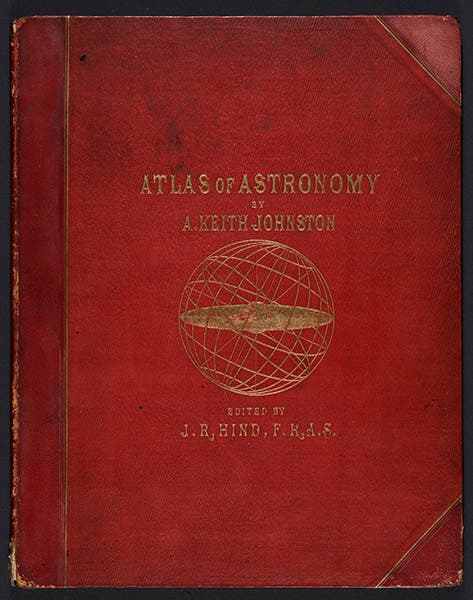
Embossed front cover, Atlas of Astronomy, by Alexander Keith Johnston, 1855 (Linda Hall Library)
Today, we look at a rather different Johnston publication, in that its subject is not geography, but astronomy. Johnston’s Atlas of Astronomy (1855) is a much slighter publication, since it has only 18 plates plus explanatory text. But it is quite a lovely production, especially if you like blue, as that hue tends to dominate views of the heavens (reminding me of another man obsessed with blue, our April 1 honoree of 2018, Cyano de Bergerac). The plates in Johnston’s Atlas of Astronomy show the cause of the seasons and tides, sunspots, the moon, explanations of solar and lunar eclipses, a diagram of the entire solar system, another of the inner solar system, the faces of the known planets (recently expanded in number to 8), comets, nebulae, and 6 plates mapping the positions of the stars and constellations.
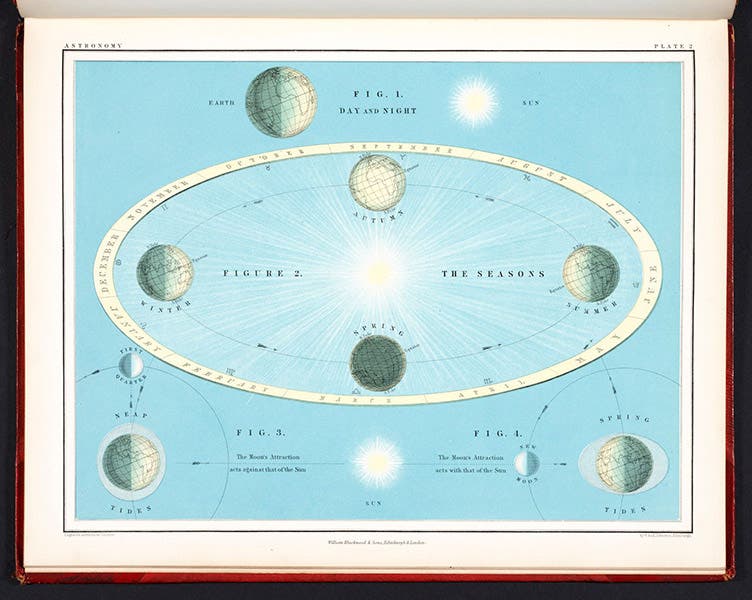
Causes of the seasons and the tides, hand-colored lithograph, Atlas of Astronomy, by Alexander Keith Johnston, plate 2, 1855 (Linda Hall Library)
The most attractive plate is probably the one that shows the faces and comparative sizes of the planets of our Solar System (plate 9, first image). The drawing of Saturn in the center was made by William R. Dawes in 1853, which is a good indication of how up-to-date Johnston tried to make his Atlas. The presence of the face of Neptune (first observed in 1846) is further testament to the currency of the atlas. Should you want to know when Mercury is going to transit across the face of the Sun, Johnston even provided a diagram, at top center, of all the projected transits of Mercury up through May 6, 1878.
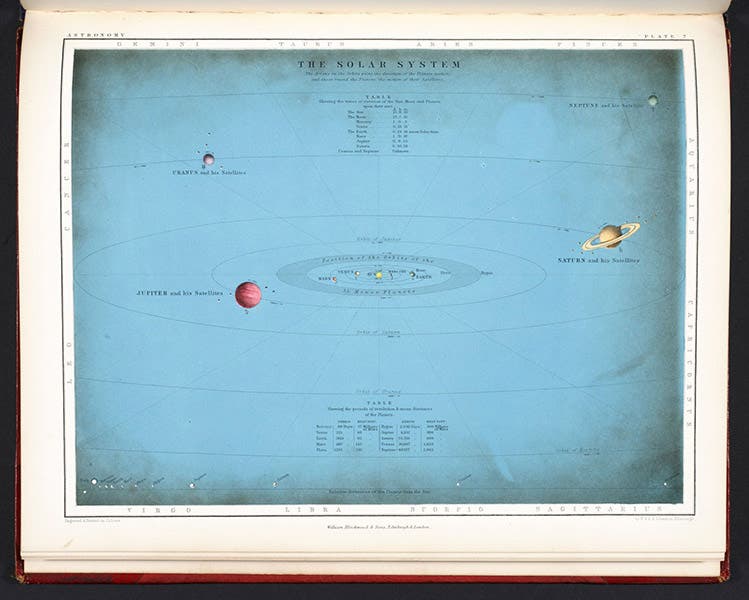
The Solar System, hand-colored lithograph, Atlas of Astronomy, by Alexander Keith Johnston, plate 7, 1855 (Linda Hall Library)
Another interesting plate offers up a diagram of planetary orbits, not to scale, because then the inner planets would not even show up (fourth image). The eighth planet Neptune is on this plate too, but now with a moon, Triton, that had been discovered by William Lassell in 1848 (it is amazing that Neptune was unknown as a planet until 1846, and two years later, astronomers were finding moons around this new planet).

Detail of fourth image (plate 7), showing the inner solar system, with the “asteroid belt” or location of the 33 known minor planets (Linda Hall Library)
But I was most intrigued by the central region of this plate, where we see a darker blue asteroid belt between the orbits of Mars and Jupiter (see detail, fifth image). The label on the belt says it is the location of "33 minor planets." The 33rd minor planet (or asteroid) was discovered in October of 1854, while the 34th was found in the spring of 1855. Since this book was published in 1855, it could hardly have been more current. It probably helped that Johnston relied on an astronomer, John Russell Hind, for accuracy in astronomical matters, and it further helped that Hind himself discovered 10 minor planets, including the 30th, Urania, found in July of 1854, while this atlas was being compiled.
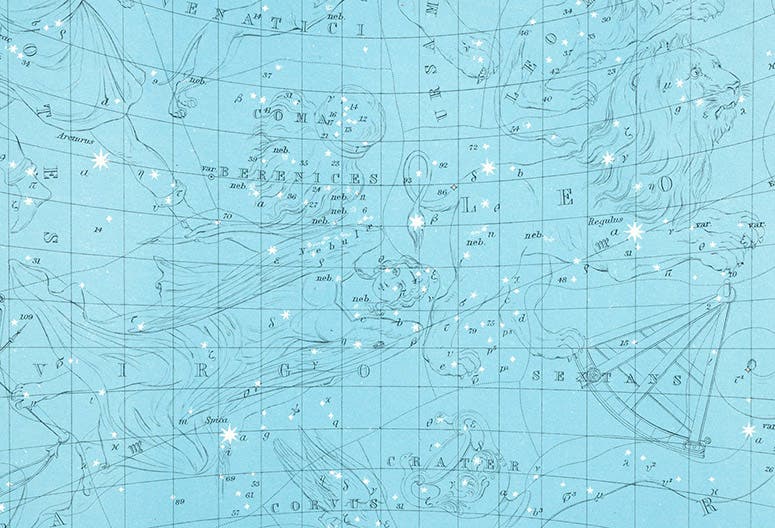
A detail of the third of the six star charts, showing the constellations Virgo, Leo, and Sextans, hand-colored lithograph, Atlas of Astronomy, by Alexander Keith Johnston, plate 15, 1855 (Linda Hall Library)
The star charts are not only visually appealing, but reliable as well, for they were based on a new star catalogue sponsored by the British Association for the Advancement of Science (BAAS), which made this popular star atlas more accurate than most professional star atlases of the time. We show a detail of the third chart (sixth image), which shows Virgo, Leo (with his little buddy Leo minor) and Sextans. In keeping with the trend in celestial atlases since the 1830s, the constellation figures are much less obtrusive in Johnston’s charts than they used to be, and the stars more prominent.
![Portrait of Alexander Keith Johnston, frontispiece, One Hundred Years of Map Making: The Story of W. and A.K. Johnston, [1925?] (scottishprintarchive.org)](https://assets-us-01.kc-usercontent.com:443/9dd25524-761a-000d-d79f-86a5086d4774/bc239a7b-84ee-415d-aadb-6ec896a62334/Johnston%2007.jpg?w=558&h=600&auto=format&q=75&fit=crop)
Portrait of Alexander Keith Johnston, frontispiece, One Hundred Years of Map Making: The Story of W. and A.K. Johnston, [1925?] (scottishprintarchive.org)
Sometime around 1925, the publishing firm of W. and A.K. Johnston issued a pamphlet celebrating the centennial of their company, founded in 1825. We do not have a copy of this pamphlet in our library, but there is a copy available online. We mention it because it has, for a frontispiece, a photo of Alexander Keith Johnston. We presume it is reliable as a likeness – it is the only one known – and reproduce it here (seventh image), even as we wish that Johnston were as cheerful in appearance as his sunny prose suggested.
William B. Ashworth, Jr., Consultant for the History of Science, Linda Hall Library and Associate Professor emeritus, Department of History, University of Missouri-Kansas City. Comments or corrections are welcome; please direct to ashworthw@umkc.edu.




![Using an astrolabe to measure the depth of a well, woodcut in Elucidatio fabricae vsusq[ue] astrolabii, by Johannes Stöffler, 1513 (Linda Hall Library)](https://assets-us-01.kc-usercontent.com:443/9dd25524-761a-000d-d79f-86a5086d4774/a998eb50-55d2-4a88-ace2-a50aa5fa86e7/Stoffler%201.jpg?w=210&h=210&auto=format&fit=crop)

